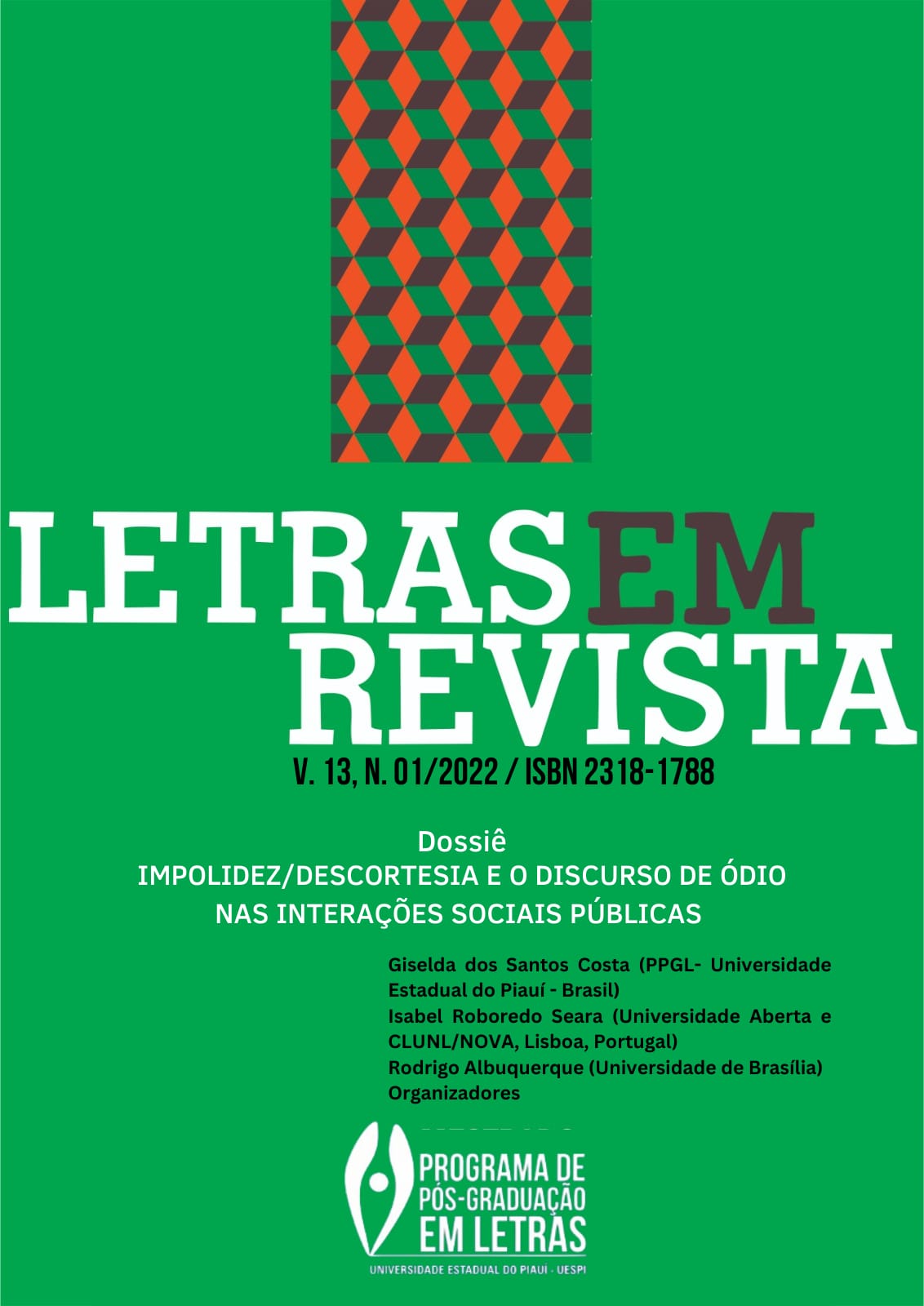Twitter: uma análise pragmática das estratégias de impolidez em comentários numa mídia social
Resumo
Este artigo está no campo da linguística-pragmática dedicado a descobrir e analisar as estratégias de impolidez de tuítes contra a fala do presidente Bolsonaro quando ele declarou aos opositores que iriam vê-lo em 2022, ano da eleição no Brasil. Os dados foram retirados na coluna de comentários do Twitter no Blog da jornalista Andreia Sadi, nos dias 03 e 04 de fevereiro de 2021. Foram coletados 227 tuítes. 110 de internautas opositores ao Bolsonaro, 100
a favor e 07 de publicidades. Analisamos 110 tuítes que pertencem ao grupo de internautas que não gostam do presidente. É um estudo descritivo qualitativo apoiado em dados quantitativos. A técnica de coleta utilizada foi o método documental. Tivemos uma análise à luz do modelo interativo de Miles et al. (2014) e com base na taxonomia de Culpeper (1996). O resultado mostra que nos 110 comentários, a estratégia de impolidez positiva teve um total de 58 (52,6%), a estratégia sarcasmo teve 27 casos (24,5%), a estratégia de impolidez negativa teve 16 casos (14,6%), a estratégia de impolidez caluniosa teve um número total de 8 casos (7,3%) e polidez retida foi a estratégia de menor frequência a ocorrer nesta pesquisa (1,1%). O estudo mostrou que a impolidez não é apenas o oposto de polidez, mas a manifestação de desaprovação e antipatia mútua por meio de certos comportamentos comunicativos que sinalizam desrespeito.
Referências
AUSTIN, J. L. How to do things with words. Oxford University Press. 1962.
BERNAL, M. Do insults always insult? genuine impoliteness versus non-genuine impoliteness in colloquial Spanish. Pragmatics, 18. 2008, 781-802.
BOUSFIELD, D. Impoliteness in interaction, Amsterdam, John Benjamins, 2008.
BROWN, P; LEVINSON, S. Politeness: some universals in language use. Cambridge: Cambridge University Press, 1987.
CULPEPER, J. Towards an anatomy of impoliteness. Journal of Pragmatics, v. 25, n.3, p. 349-367, 1996.
CULPEPER et al. Impoliteness revisited: with special reference to dynamic and prosodic aspects. Journal of Pragmatics 35 (10-11). 2003, 1545-1579
CULPEPER, J. Impoliteness: using language to cause offense. Cambridge: Cambridge University Press, 2011.
CULPEPER, J. Impoliteness strategies. In: CAPONE, A.; MEY, J. L. (Org.) Interdisciplinary studies in pragmatics, culture and society. New York: Springer, 2016. p. 421-445.
CRYSTAL, D. A dictionary of linguistics and phonetics. 2nd ed. Oxford: Blackwell, 240, 1985.
GALL, M. D.; GALL, J. P.; BORG, W. R. Educational research: An introduction. Boston: Pearson Education, 2007.
GRAHAM, S. L.; HARDAKER, C. (Im)politeness in Digital Communication. In: culpeper, J.; Haugh, M, Kádár, D. Z. (org.). The palgrave handbook of linguistic (im)politeness. London: Palgrave Macmillan, 2017. p. 785-814.Disponivel em:< https://doi.org/10.1057/978-1-137-37508-7_30>. Acesso em 02 fev.2021.
GRICE, H. P. Logic and conversation. In P. Cole, & J. L. Morgan (Eds.), Syntax and Semantics, 3, New York: Academic Press.1975. pp. 41-58.
GU, Y. Politeness in modern chinese. Journal of Pragmatics, 14, 1990.237-57.
HATIPOLU, Ç. (Im)politeness, national and professional identities and context: Some evidence from e-mailed ‘Call for Papers’. Journal of Pragmatics, 39, 760-773, 2007.
KANKAANRANTA, A. Hej Seppo, could you pls comment on this! Internal Email communication in lingua franca English in a multinational company. PhD dissertation. 2005. University of Jyvaskyl. Centre for Applied Language Studies. 460p. Disponivel em< http://ebooks.jyu.fi/solki/9513923207.pdf>. Acesso em 10 Jan. 2021.
KECSKES, I. Intercultural pragmatics, Oxford, Oxford University Press, 2013.
KOCH, I.G.V. A inter-ação pela linguagem. São Paulo: Contexto, 1992
KULKARNI, P. What is triangulation of data in qualitative research? Is it a method of validating the information collected through various methods? 2013 Disponível em: < https://qrgo.page.link/LSrFT>. Acesso em: 10 fev. 2021.
LEVINSON, Stephen C. Pragmatics. Cambridge University Press, Cambridge, 1983
LIMBERG, H. Impoliteness and threat responses. Journal of Pragmatics, 41(7), 1376-1394, 2009.
MILES, et al., Qualitative data analysis: A methods sourcebook (3rd ed.). Thousand Oaks, CA: SAGE Publications, 2014.
MILES, M. B., HUBERMAN, A. M. Qualitative data analysis: An expanded sourcebook (2nd ed.). Sage Publications, Inc, 1994.
MEY, J. L. Pragmatics: an introduction. 2nd edn. Oxford: Blackwell, 1993.
SEARLE, John R. Expression and meaning. Cambridge: Cambridge University Press, 1979.
SPENCER-OATEY, H. Rapport management: A framework for analysis. In: SpencerOatey, H. (Ed.), Culturally speaking: culture, communication and politeness theory (2nd ed.). Continuum, London. 2008, pp. 2-47
WATTS J. R. Politeness. Cambridge University Press, Cambridge, 2003.
WIERZBICKA, A. Cross-cultural pragmatics: The semantics of human interaction. Bertin: Mouton De Gruyter, 1991.
YULE, G. Pragmatics. Oxford: University Press, 1996





.jpg)



